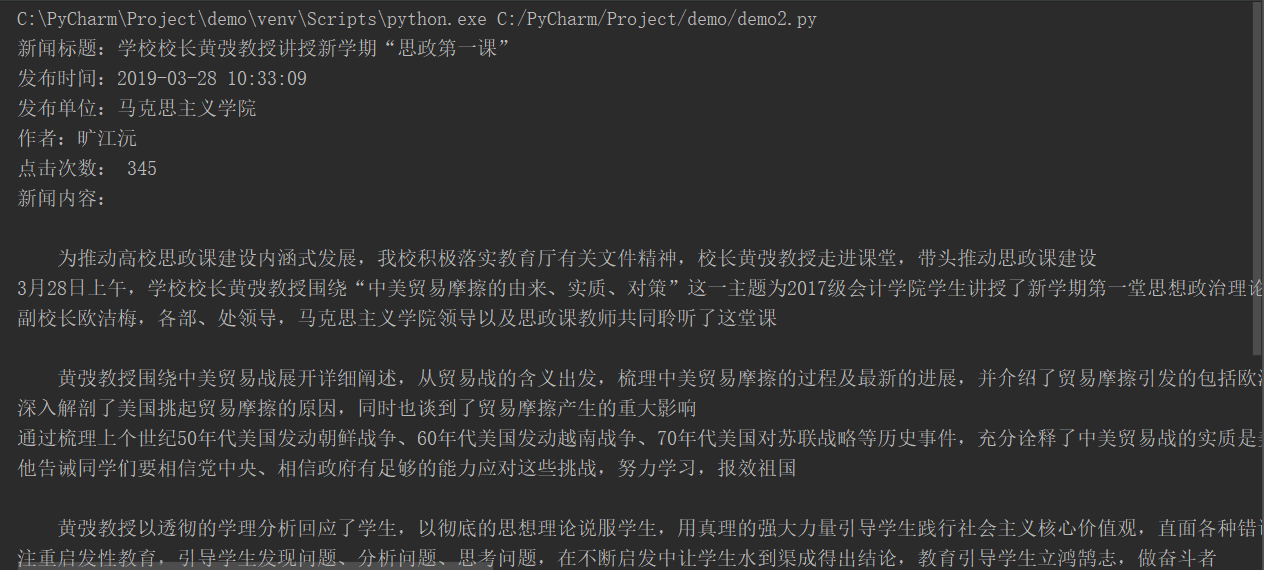1. 简单说明爬虫原理
简单地说,互联网就像一张大的蜘蛛网,数据便是存放在蜘蛛网的各个节点,爬虫就像一只蜘蛛,沿着网络抓去自己需要的数据。爬虫:向网站发起请求,获取资源后进行分析并提取有用的数据的程序。
2. 理解爬虫开发过程
1).简要说明浏览器工作原理;
在浏览器输入内容,浏览器会将请求发送到服务器,服务器响应后返回响应结果给浏览器,然后根据响应向用户显示相关内容。
2).使用 requests 库抓取网站数据;
requests.get(url) 获取校园新闻首页html代码
3).了解网页
写一个简单的html文件,包含多个标签,类,id
4).使用 Beautiful Soup 解析网页;
通过BeautifulSoup(html_sample,'html.parser')把上述html文件解析成DOM Tree
select(选择器)定位数据
找出含有特定标签的html元素
找出含有特定类名的html元素
找出含有特定id名的html元素
3.提取一篇校园新闻的标题、发布时间、发布单位、作者、点击次数、内容等信息
如url = 'http://news.gzcc.cn/html/2019/xiaoyuanxinwen_0320/11029.html'
要求发布时间为datetime类型,点击次数为数值型,其它是字符串类型。import requests
代码:
import requests import bs4 from bs4 import BeautifulSoup as bs from datetime import datetime def html(url): response=requests.get(url=url) response.encoding='utf-8' soup=bs(response.text,'html.parser') return soup url="http://news.gzcc.cn/html/2019/xiaoyuanxinwen_0328/11080.html" url2='http://oa.gzcc.cn/api.php?op=count&id=11080&modelid=80' #标题 title=html(url).select('div .show-title')[0].text print("新闻标题:"+title) #时间 time1=html(url).select('div .show-info')[0].text.split()[0].split(':')[1] time2=html(url).select('div .show-info')[0].text.split()[1] Time=time1+ ' ' +time2 print("发布时间:"+Time) #发布单位 comFrom=html(url).select('div .show-info')[0].text.split()[4].split(':')[1] print("发布单位:"+comFrom) #作者 write=html(url).select('div .show-info')[0].text.split()[2].split(':')[1] print("作者:"+write) #点击次数 count=html(url2).text.split()[0].split('html')[-1] ss="()';" for i in ss: count=count.replace(i,'') co=int(count) print("点击次数:",co) #内容 cont=html(url).select('div .show-content')[0].text.replace('。',' ') print("新闻内容:") print(cont) #字符串转化为Data类型 now=datetime.strptime(Time,'%Y-%m-%d %H:%M:%S') print(type(now)) #Data转化字符串 now1=datetime.now() now1=datetime.strftime(now1,'%Y{y}-%m{m}-%d{d} %H{H}:%M{M}:%S{S}').format(y='年',m='月',d='日',H='时',M='分',S='秒') print(now1)
运行结果:
